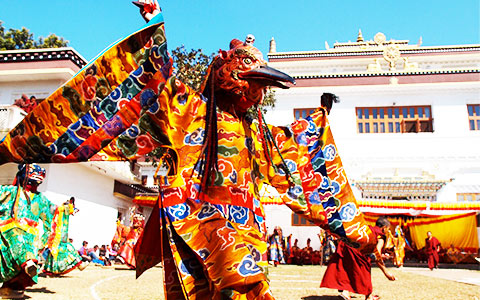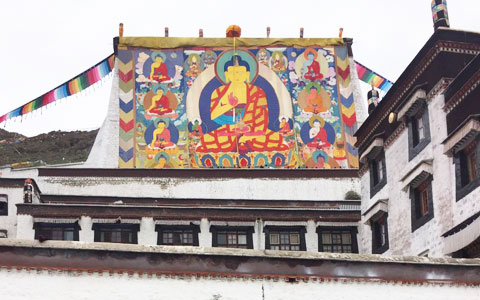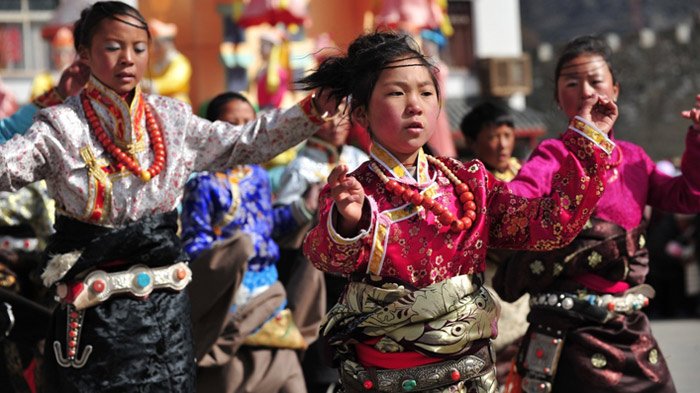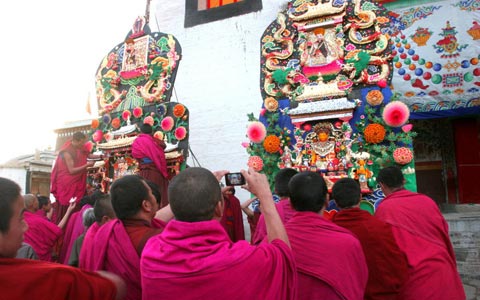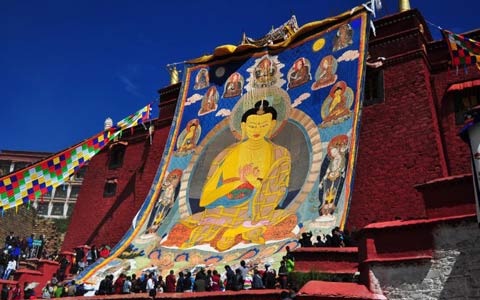Tibetan Festival Calendar 2024: Upcoming Tibetan Festivals to Experience for Your Tibet Tours
With a history of at least 1500 years, Tibet was isolated from outside world for a long time due to its poor transportation system, but just because of the long-term isolation, unique Tibetan culture has been breeding at the top of the world. Nowadays, the transportation at this area has been greatly improved with the operation of Qinghai-Tibet Railway and many airlines. More and more tourists flock into Tibet by train or air to enjoy the breathtaking natural beauty and experience the splendid culture of Tibet. In order to help tourists to make an earlier plan of travelling to Tibet in 2023, Tibet Travel Org works out the latest Tibetan Festival Calendar for free download. The Tibetan festival calendar takes in the major traditional festivals in Tibet.
2024 Tibetan Festivals & Calendar
| Tibetan Festivals | Tibetan Calendar | 2024 Solar Calendar | Active Region | Related Tour Itinerary |
| Tibetan New Year (The most important) |
1st of the first Tibetan month | Feb.10 | TAR | 7 Days Tibet New Year Festival Tour |
| Monlam Prayer Festival | 4th - 11th of the first Tibetan month | Feb.13 - Feb.20 | TAR | Contact us to tailor your own trip |
| Butter Lantern Festival | 15th of the first Tibetan month | Feb.24 | Jokhang Monastery | 4 Days Lhasa Impression Small Group Tour |
| Saga Dawa Festival (The holiest one) |
15th of the fourth Tibetan month | May.23 | TAR | 16 Days Tour Kailash in Saga Dawa Festival |
| Tashilhunpo Thangka Unveiling Festival | 15th of the fifth Tibetan month | Jun.22 | Tashilhunpo Monastery | 8 Days Tashilhunpo Festival Tour |
| Samye Festival | 15th of the fifth Tibetan month | Jun.22 | Samye Monastery | 5 Days Short Visit to Samye Small Group Tour |
| Chokor Duchen Festival | 4th of the sixth Tibetan month | Jul.9 | TAR | Contact us to tailor your own trip |
| Ganden Thangka Unveiling Festival | 15th of the sixth Tibetan month | Jul.21 | Gandan Monastery | 5 Days Lhasa and Ganden Monastery Small Group Tour |
| Shoton Festival (The most popular) |
30th of the Sixth Tibetan month | Aug.4 | Lhasa | 5 Days Shoton Festival Experience Tour |
| Labrang Festival | 8th of the Seventh Tibetan month | Sept.11 | TAR | Contact us to tailor your own trip |
| Karma Dunba (Bathing Festival) |
17th of the Seventh Tibetan month | Sept.19 | TAR | Contact us to tailor your own trip |
| Nagqu Horse Racing Festival | - | Aug.10 | Nagqu | 8 Days Tibet Nagqu Horce Racing Festival Budget Travel by Train |
| Lhabab Duechen | 22nd of the Ninth Tibetan month | Nov.22 | TAR | Contact us to tailor your own trip |
| Palden Lhamo Festival | 15th of the Tenth Tibetan month | Dec.15 | TAR | Contact us to tailor your own trip |
| Ganden Nga-Choe | 25th of the Tenth Tibetan month | Dec.25 | TAR | Contact us to tailor your own trip |
Tibetan calendar is lunisolar calendar, that is, the structure of the Tibetan calendar is based at the same time on the cycles of the sun and the moon. The Tibetan year is composed of either 12 or 13 lunar months, each beginning and ending with a new moon. A thirteenth month is added every two or three years, so that an average Tibetan year is equal to the solar year.
The official Tibetan calendar is lunar, but in Tibetan calendar making different systems are used, which harmonize solar and lunar factors. There are three systems for defining the New Year:
1. The Tibetan New Year (Losar) falls around February - lunar system;
2. The Kalachakra New Year falls in April - solar system;
3. The Elemental New Year falls around December - lunar system.
The Tibetan New Year (Losar)
The official Tibetan New Year, Losar, is celebrated on the first day of the first month of the Tibetan lunar calendar and it falls around the February new moon. The first month is called Hor-zla (Mongolian month) because of their Mongolian connection.
The history behind Mongolian months began when the Mongolian ruler Chingis Khan invaded parts of Western China. He took over the Chinese months and renamed them as Mongolian months. The day of victory was then celebrated as New Year. In the 13th century the Tibetan Sakya Drongon scholar, Chögyal Pagpa, and his uncle Sakya Pandita, introduced Buddhism to Mongolia. Chögyal Pagpa became a teacher of Chingis Khan's grandson Kubilai Khan, who was the ruler of Mongolia at the time. Along with Buddhism also came the Kalachakra system, and Mongolian months were converted to be equivalent to Kalachakra months. Mongolian rulers named Chögyal Pagmas family Kings of Tibet and this probably helped the Kalachakra system become Tibet's official calendar. In return, the Mongolian Hor-zla month also became the Tibetan New Year as a sign of friendship between the two nations. And to this day the Tibetans still celebrate Chingis Khan's victory over the Chinese tribes.
The Kalachakra New Year and the Elemental New Year
Tibetan calendar is also prepared for observing either the Kalachakra New Year or the Elemental New Year. The Kalachakra New Year is used for planetary calculations for astronomy and astrology. The Kalachakra year is constituted by the Sun's movement through the astrological signs in the Sidereal Zodiac, and this solar year has 365 days. The Kalachakra system uses the same twelve Zodiac houses and planets as the Indian calendar do. When the Sun is entering into Aries, it also marks the Kalachakra New Year, which is actually the third month of the Tibetan Calendar and falls in April. The Elemental New Year falls in December and is used in the calculation of an Elemental horoscope to define a person's age.
Keeping these different systems apart is very important because of their own purposes. When the calendar of the Tibetan New Year defines the official time calculation, then systems of the Kalachakra New Year and the Elemental New Year are essential for astrological calculations.
Each Tibetan year is ruled by one of the five elements (iron, wood, water, fire and earth) and one of twelve animal signs (Mouse, Ox, Tiger, Rabbit, Dragon, Snake, Horse, Sheep, Monkey, Rooster, Dog and Pig) as in Chinese calendars, but they start the year on different dates and the months have different lengths. So it is very important not to mix Tibetan and Chinese systems together.
Tibetan years follow twelve-year animal cycles. One element rules two years in a row and then changes to the next element, while an animal sign will rule for one year at a time. The Year 2000 was an Iron-Dragon year and the year 2001 was an Iron-Snake year. The year 2002 was a Water-Horse year, and so forth. The 60 year cycle of all combinations of the five elements and twelve animals is called Rab-byung. We are now living in the 17th. Rab-byung, which began in 1987.
The first year in the Tibetan calendar dates back to the Kalachakra year, 1027. Actually the system of animal years already started in the middle of 600 A.D. under the influence of the teachings of a Chinese princess who married the Tibetan king, Songtsen Gampo. The system of 60 year cycles, Rab-byung, was introduced around the 10th century and in the 11th century it was widely used in Tibet. Kalachakra teachings were blended with Elemental astrology, and when Tibetan scholars made the very first Tibetan calendar they used Rab-byung for counting the years. As Kalachakra teachings were the foundation for chronological calculations, it was decided that the official date of introduction of Kalachakra would be Year One. Year 1027 was a Fire-Rabbit year and from then a Fire-Rabbit year became the first year in Tibetan Rab-byung, while the Chinese 60 year cycle always begins with a Wood-Mouse Year.
Tibetan months are also ruled by the 12 animal signs. From January to December, the months are respectively ruled by Dragon, Snake, Horse, Sheep, Monkey, Rooster, Dog, Pig, Mouse, Ox, Tiger and Rabbit by sequence.
Tibetan calendar calculation is a very complete and scientific calendar calculation system. It was praised as "the most authentic calendar calculation" by Chinese Academy of Sciences. It is very insteresint that there are double day and leap day in Tibetan calendar to match the order of solar day and lunar day. If there is no double day and leap day in the month, this month is called "auspicious month".

Energetic, responsible and reliable, Sonam is a guide with more than seven years experience informing visitors about heritage sites and attractions places in Tibet.
Related Articles & Posts
Most Popular Tibet Tour Packages
-

Lhasa - Gyantse - Shigatse - Everest Base Camp - Shigatse - Lhasa
USD939
View Details -

Lhasa - Gyantse - Shigatse - E.B.C - Saga - Kailash Trek - Darchen - Lake Manasarovar - Saga - Gyirong - Tingri - Lhasa
USD2059
View Details -

10 Days Lhasa to Everest Base Camp and Namtso Lake Small Group Tour
Lhasa - Gyantse - Shigatse - EBC - Shigatse - Lhasa - Namtso Lake - Damxung - Lhasa
USD1289
View Details -

8 Days Driving Across Himalaya Overland Adventure from Kathmandu to Lhasa
Kathmandu - Gyirong - Everest Base Camp - Tingri - Shigatse - Gyantse - Lhasa
USD1069
View Details -

4 Days Lhasa Impression Small Group Tour: Explore the Heart of Tibet and Mingle with the Locals
Lhasa
USD509
View Details -

Lhasa - Gyantse - Shigatse - Everest Base Camp - Gyirong - Kathmandu
USD979
View Details -

Lhasa - Gyantse - Shigatse- Lhasa
USD799
View Details -

13 Day Lhasa, Mt. Everest, Mt. Kailash, Lake Manasarovar and Kathmandu Adventure Tour
Lhasa - Gyantse - Shigatse - EBC - Saga - Darchen - Kailash Trek - Darchen - Saga - Gyirong - Kathmandu
USD2059
View Details


.jpg)



